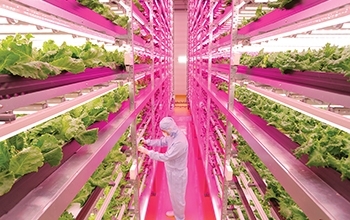
The US DOE has just released a report that examines the energy-saving potential of LED lighting in horticultural applications. All three main categories of indoor horticulture were investigated: supplemented greenhouses, which use electric lighting to extend the hours of daylight, supplement low levels of sunlight on cloudy days, or disrupt periods of darkness to alter plant growth; non-stacked indoor farms, where plants are grown in a single layer on the floor under ceiling-mounted lighting; and vertical farms, where plants are stacked along vertical shelving to maximize grow space, and the lighting is typically mounted within the shelving units.
Among the findings:
- LED lighting offers 24% to 30% reduction in electricity consumption compared with incumbent lighting technologies
- LEDs "can enable more efficient and effective growth and control of the ultimate product."
- Of the three categories of indoor horticulture, vertical farms have seen the highest adoption of LED lighting, which comprises 66% of all lighting in that application, while LED products make up only 2% of the lighting in supplemented greenhouses and 4% of the lighting in non-stacked indoor farms
The DOE states that if all horticultural lighting today was converted to LED technology, annual lighting consumption would be reduced to 3.6 TWh, which represents energy savings of 40% and translates to $240 million saved.
Additionally, LEDs commonly produce less waste heat or more easily-managed waste heat than incumbent technologies, so there could be additional savings through reduced facility cooling demands as well.
You can download the entire report here.
